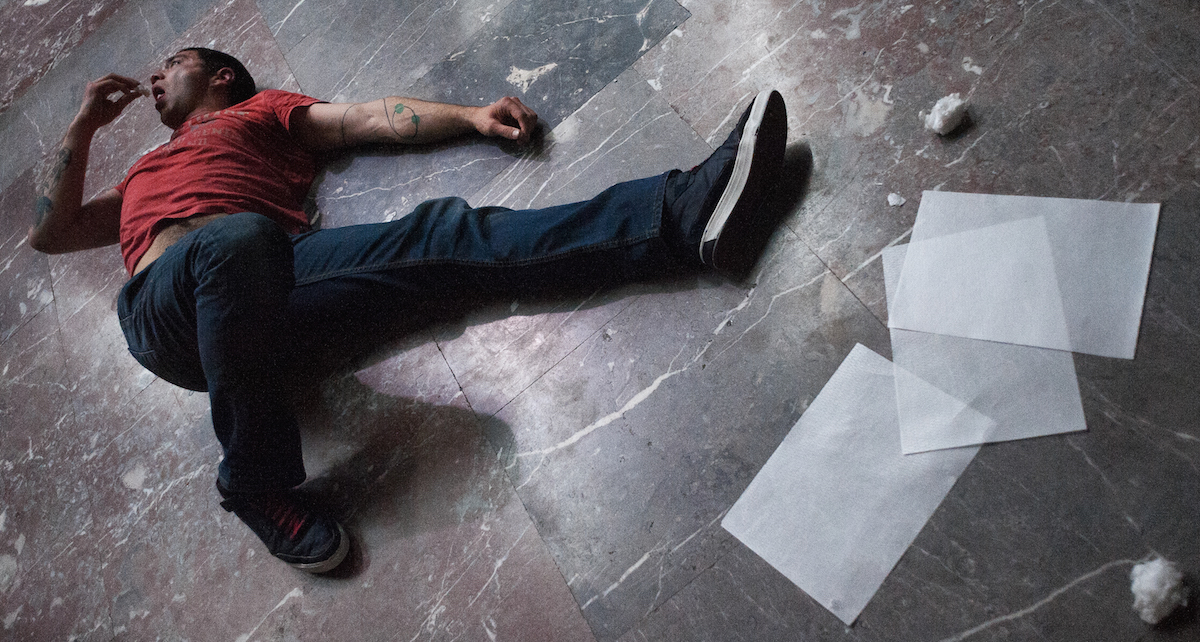Carriageworks, Sydney.
Sunday 20 March 2016.
As part of the 20th Biennale of Sydney, Carriageworks hosted a presentation led by Stephanie Rosenthal, artistic director of the Biennale, and with choreographer Boris Charmatz, known for being an innovator in dance. Rosenthal, whose key curatorial practice is the exploration of the relationship between visual arts and performance, had a discussion with Charmatz on the subject: “Is the public space the right architecture for a Musée de la dance?” The talk was followed by a performance of Charmatz’s work, manger.
Since 2009, Charmatz has been director of Musée de la danse (MDLD), a “dancing museum”, located in Rennes, France. MDLD is a place but also a “nomadic idea which can move elsewhere, shelter time, void and talk, nudes, things political, discussions, works and fantasies, and sometimes even all of it at the same time”. After many years of dreaming of a proper sustainable building, Charmatz and MDLD are now pursuing a series of attempts in and for public spaces. From the contemporary stress about togetherness to street dance to permeable choreographies, the keynote address at Carriageworks raised many thought-provoking issues and discussions. Charmatz is a “traditional” yet radical thinker undermining audience expectations. The MDLD is a large ‘’concrete’’ centre for experimentation where people can write and question more with the absence of barriers and demarcations of the body.
Charmatz expressed that he is concerned that public spaces have almost disappeared as a place for performance. He is looking for new ideas for movement. He talked about the performance he organized at Tate Modern in London and the massive demonstrations at New York City’s Times Square, for example — how crowds cross and pass through public spaces. He asked the question, “How can dance be present in visual arts?” He looked at the preservation of objects and the preservation of dance, the movement of human bodies disturbing each other. Everyday movement, social and street dance are included.

Boris Charmatz’s, ‘manger’, 2015. Photo by Beniamin Boar.
At the far end of the building, one of the cavernous sections of Carriageworks was used for Charmatz’s manger (To Eat), which was created in 2014 and has been performed at venues such as Tate Modern. What role does the mouth and, specifically, eating play in dance and performance?
There were no seats; instead, the audience stood the entire time and milled around while observing. There is no real signal for its starting; rather, it begins quite unobtrusively. There is a cast of roughly 13 performers, some in trainers or heels, some barefoot, and all clad in often colourful, casual clothing and holding sheaves of rice paper among the audience as we entered.
Manger examines choreography of the mouth, of food, voices, breath, saliva. Rice paper is chewed and eaten by the performers, sometimes in tiny strips and daintily, others frantically and passionately. A woman licks her arm, another performer his shoes. Some performers writhed, screamed or mumbled and emitted strange gulps, coughs and gasps.
Music drawn upon as the self-generated soundtrack of the performers ranged from Ligeti’s “Lux Aeterna”, The Kills’ “Ticket Man” and Daniel Johnston’s “King Kong” to Corelli’s “La Folia” and Beethoven’s Symphony No. 7. The music was hummed and sung (sometimes with mouth full). The performers curled up foetally, squatted, rolled, slid or twisted themselves acrobatically into various positions, both on and off the floor. One performer “walked” little pieces of the paper up another’s arms, another dropped a piece of paper on another performer’s shoe. Yoga poses and Pilates movements are included, as are everyday movements and splits. A torn paper sculpture was created by one performer. At one point, several dancers rolled together in a log-like fashion. Some performers grabbed their ribs or guts with attending howls and scraping sounds. At times, the paper was regurgitated, and sometimes the performers acted almost as if they were ill. Toward the end, there was quite a bit of jumping and more agitated, awkward yet vigorous, phrases of movement.
Manger is perhaps a cross between a sound object and a mobile installation, a digestion of the world perhaps, a “swallowed reality”. A disturbing, challenging, austere and “difficult” piece performed with commitment.
By Lynne Lancaster of Dance Informa.
Photo (top): Boris Charmatz’s, ‘manger’, 2015. Photo by Beniamin Boar.

















